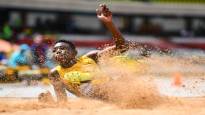by Jonathan Edwards almost 28 years have passed since the men’s triple jump world record of 18.29 this year. There have been enough entrepreneurs over the years.
It has also come close, like the USA Christian Taylor at the 2015 World Championships in Beijing. He missed the ME reading by eight centimeters.
Earlier this month, at the US University NCAA Championships, there was a reminder that the ME could crash very soon. 18 year old Jamaican sensation Jaydon Hibbert bounce Louisiana Baton Rouge new youth ME readings 17.87.
Hibbert healed Volker Main from almost 40 years ago, the former record result of the age group with a single throw of 37 cents. He started the triple jump only three years ago.
The Jamaican talent has improved his record by leaps and bounds. At the end of 2021, his record was 16.05 and last year 17.27.
– I thought he could jump 17.80. It was really amazing that he was able to do that, coach Travis Geoffert rejoiced later In an interview with SportsMax TV (you will switch to another service).
A top talent of three stripes
The men’s triple jump has been missing a junior sensation like Hibbert.
– You can’t make a tough triple jumper out of anyone, no matter what you do. A certain level of talent must be found. Sometimes there are really super talented guys, but of course rarely. He is the toughest triple jump coach that has been found Tuomas Sallinen says.
Geopfert stated in an interview with SportsMax that the 18-year-old talent needs to keep the big picture in mind. This has been seen, for example, in competitions.
After his record jump in the second round, he left the race. Hibbert won the junior WC gold last year with a competition record of 17.27.
That time too, he missed the last four jumps.
– They have jumped the guy very sparingly. After a good result, the race has been canceled right away. Skillfully, those powers have been moved forward so that risks have not been taken and jumped by force. Of course, there are plenty of risks, Sallinen knows.
1. Jonathan Edwards GBR 18.29 (-95)
2. Christian Taylor USA 18.21 (-15)
3. Will Claye USA 18.14 (-19)
4. Kenny Harrison USA 18.09 (-96)
5. Pedro Pablo Pichardo POR 18.08 (-15)
6. Teddy Tamgho FRA 18.04 (-13)
The dangers of the sport
Hibbert’s potential is reflected in the fact that the record jump came at a speed of 12 steps.
– Normal paces are 16–22 steps. He is a really hard worker. With 12 steps from his place, surely no one has jumped that much, says Sallinen.
Hibbert has jumped far even at ten and eight paces. According to coach Geopfert, Hibbert is trying to move to a 14-step pace in the summer.
Sallinen says he doesn’t know how much speed reserve Hibbert has.
– If there is such a reserve that he is able to come harder by extending the speed and is able to keep the jump together, then without anything else he will fly further. But if the jump doesn’t stay together, it won’t work or you’ll get injured.
If the technology keeps up with the faster pace, we might see quite a bounce from Hibbert in the near future. We are talking about a new world record.
– I don’t see any problem with adding half a meter to that. I would emphasize that the triple jump is a really high-potential sport. Powers grow wildly as you go further. It’s completely different to jump 16 or 17 meters. When you go towards 18 meters, the pitch keeps growing, Sallinen reminds.
A total of six jumpers have broken the 18-meter mark. Four of them have done it in the 2000s.
Will 18 meters break?
For example, many junior stars have entered the sport from Cuba. However, their union has not led to similar glory on the men’s side.
For example, five years ago at the Tampere Junior World Championships, at the age of 17, he jumped to the championship and in the same year clocked 17.41 Jordan A. Diaz has been at best eighth at the World Cup or Olympic level.
– At least there hasn’t been a breakthrough like that yet. The triple jump is often a sport of patient and suffering athletes. There is bound to be some suffering at some point.
The World Championships in August are a difficult time for a university athlete like Hibbert. According to Salline, it is typical for NCAA athletes that they do their best precisely at the NCAA Games.
– First there was the indoor season and now it’s the NCAA outdoor season. The competition season is long and then there is a long break. It must be hard to decide whether to train or compete.
The men’s triple jump season has started with promising signs. In addition to Hibbert’s young ME, for example long-term successes Pedro Pablo Pichardo has flashed his skills.
He jumped a wind result of 17.91 at the opening of the Diamond League season.
The last time the 18-meter limit was broken on outdoor tracks was four years ago, when the USA Will Clay did it twice.
Two years ago in Burkina Faso Hugues Fabrice Zango jumped in the hall 18.07.
– An even season is coming. As a competitor, Pichardo has proven to be steadier and more confident. I consider him the pre-favorite considering the value races. Zango has been more of a small competition jumper.
– Let’s see if Hibbert breaks through to challenge already this summer. It’s also possible.
